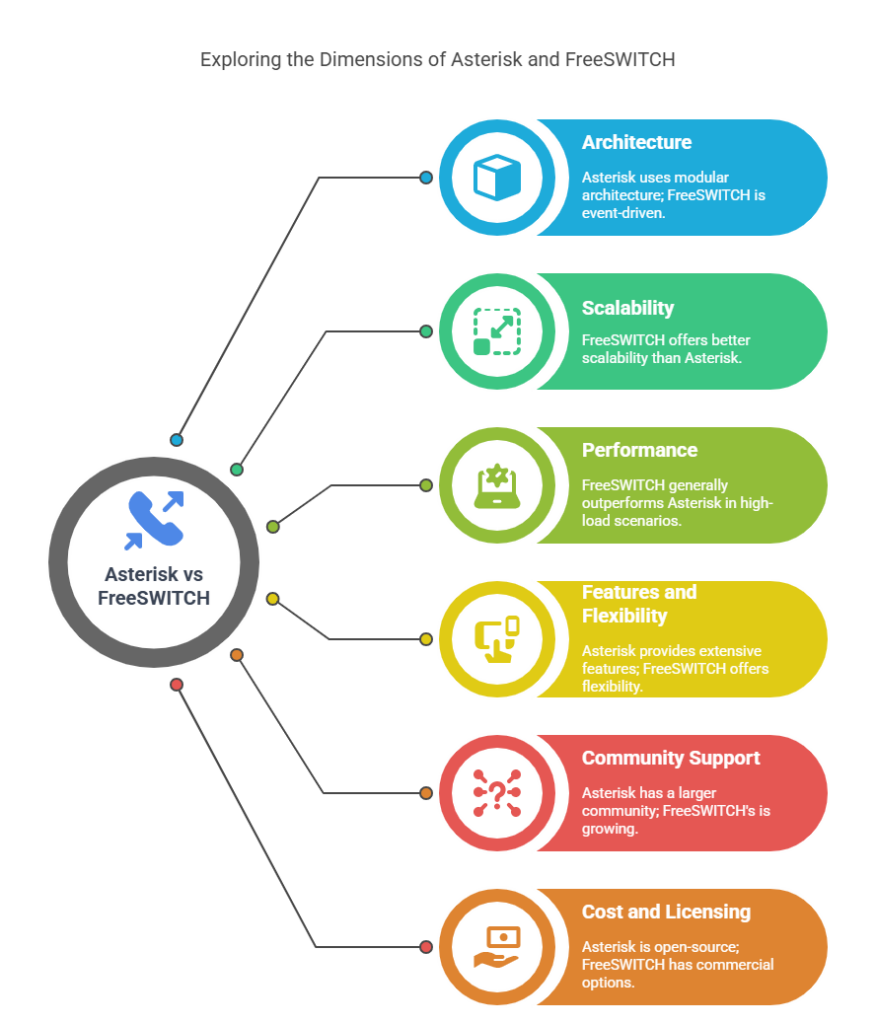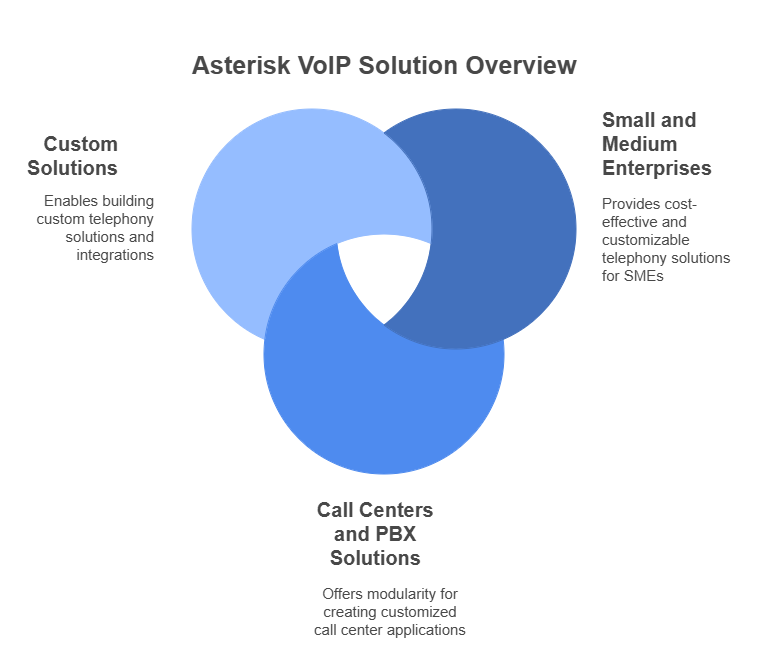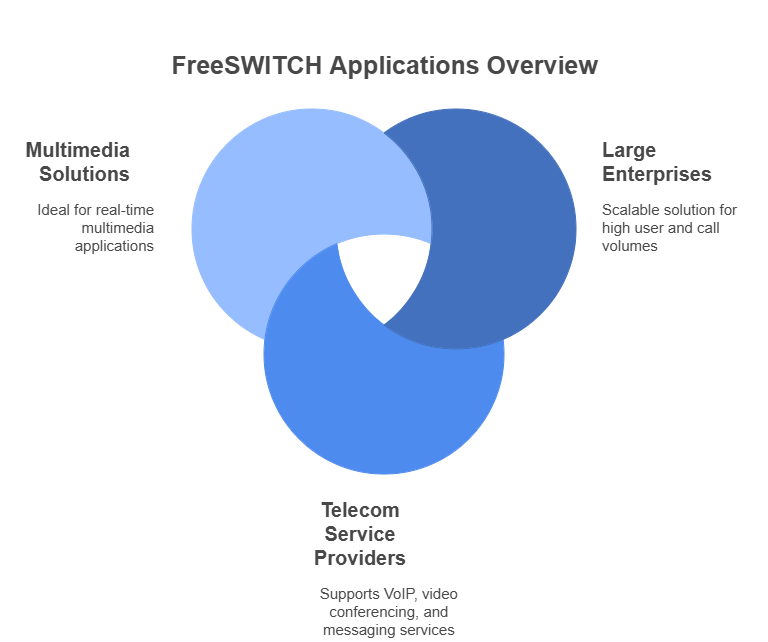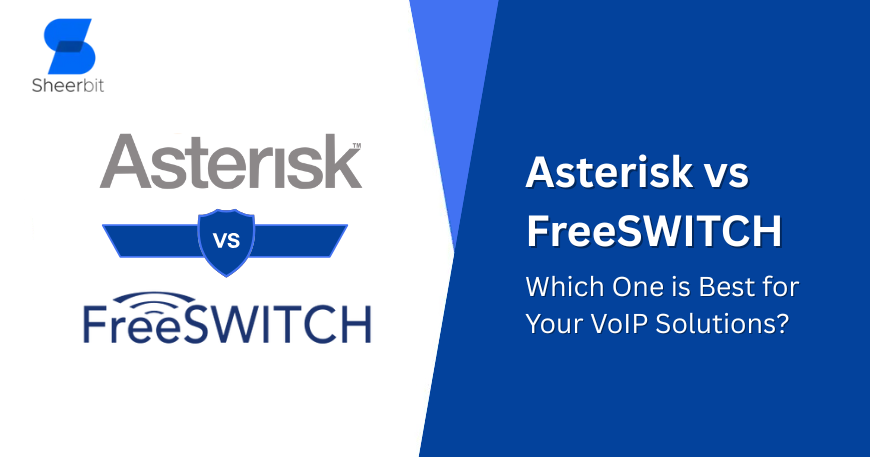Quick Summary:
Asterisk and FreeSWITCH are among the most popular open-source VoIP platforms to create customized telephone and telecom systems. Asterisk has a longstanding reputation as a customizable and flexible platform that is well suited for anyone looking for customized solutions. FreeSWITCH is also a strong contender for larger deployments or for any business that needs multimedia features like video conferencing. Your decision on which platform to adopt will depend on your organization’s size, your performance needs, and the features you want to create a system for your organization. Both have their pluses and minuses regardless of the situation, and a development service that can implement one or both of these platforms and customize it with the features you need will create the best solution for your business.
Introduction
VoIP (Voice over Internet Protocol) has transformed the way we communicate, providing businesses the opportunity to save money while increasing efficiency. Two of the leading open source platforms in the VoIP solution movement are Asterisk and FreeSWITCH. Both platforms enable businesses to custom build communication services based on VoIP technology that can range from simple call centers to complex multimedia communications solutions.
Asterisk and FreeSWITCH have been around for a while, each have developed a loyal group of users, and both have a strong community support behind them. However, the differences between either platform often just come down to a true understanding of some of their beneficial features, differences, and what’s best for your business?
This blog will cover an in-depth look into the features, differences between the two platforms and help you decide which platform fits your business interests as it relates to VoIP infrastructure.
2. What is Asterisk?
Asterisk is considered one of the big boys (feature-rich) open source communication platforms (systems). Asterisk was developed in 1999 by Mark Spencer as a way to build telephony applications, including but not limited to VoIP, PBX (Private Branch Exchange), IVR (Interactive Voice Response) systems, and call centers. Over the course of time Asterisk has become one of the most powerful and flexible platforms to build other telecommunication services or applications from.
Asterisk can be used for customers telephony needs by organizations both large and small. Asterisk creates even more flexibility for the user by offering modules that can be further customized by the user to their individual needs from call routing, voicemail systems, interactive services, and billing systems. Asterisk can also leverage different telecommunications protocols including SIP (Session Initiation Protocol) – which is important when working with lotsIts modular stack allows businesses to configure their systems as they want. Developers are also able to write scripts or use third-party modules, enhancing Asterisk’s functionality and capacity for development.
3. What is FreeSWITCH?
FreeSWITCH is an open-source project developed by Anthony Minessale and others at SignalWire as an alternative to Asterisk. FreeSWITCH was created for scale and performance, made primarily as a full telecommunications platform for both high-throughput and high-performance usage.
FreeSWITCH is widely known for its ability to support voice, video and instant messaging, as well as the multitude of multimedia protocols that it can support, FreeSWITCH is a solid choice for companies that want to provide other communications beyond just voice. FreeSWITCH was created to be highly modular, meaning companies are able to add many different capabilities or features to their communication systems with little risk of disrupting the core architecture.
One of the main reasons FreeSWITCH has gained traction as a project is its scalable approach. It is intended only to provide code that can handle tens of thousands of simultaneous calls with low latency, while being able to deliver the same performance for any type of deployment, including in the cloud or service provider perspective.
4. Asterisk vs FreeSWITCH: Fundamental Differences

4.1 Architecture
Both Asterisk and FreeSWITCH have modular architectures, however, each projects it in a different way. Asterisk uses a more traditional architecture while providing much of the flexibility through direct use of configuration files and modules. Asterisk is a modular application, as you are free to pick and choose which components of Asterisk you will install into your system stack and how you want to operate it makes it very easy to integrate.
FreeSWITCH adopts more of a contemporary approach to architecture compared to Asterisk. FreeSWITCH readily recognizes the rapid expansion of features and services with the focus being on creating a scalable platform. Being modular is directly tied into the core system, helping to deploy systems easily and enabling larger systems to maintain better performance.
4.2 Scalability
FreeSWITCH’s scalability is one of its stand-out features. It was designed for deployment on a very large scale, having a focus on performance and efficiency. FreeSWITCH can output tens of thousands of concurrent calls, thus making it the go-to platform for service providers and large enterprises. Asterisk is scalable, but it does require some additional tuning and setup to operate in larger environments. Asterisk can scale to support enterprise level, but FreeSWITCH will typically just do better with the heavy calls loads to begin with.
4.3 Performance
In general, FreeSWITCH is better than Asterisk performance wise, especially in the environments where we care about low latency and high throughput. FreeSWITCH is optimized to handle multimedia communication, which includes voice and video. Asterisk, while also very functional, does lack the capability to handle extremely high concurrent call volumes unless it is signed to be optimized, and does not support anywhere near the same level of multimedia services or hardware that FreeSWITCH was designed to support.
4.4 Features and Flexibility
Both platforms support an abundance of features, and they both also have a great many features that may differ based on the fact that FreeSWITCH and Asterisk both have a differing set of out the box features. The biggest advantage that Asterisk has over FreeSWITCH is its flexibility with creating custom telephony applications. For example, Asterisk is a great platform for businesses that need custom IVR systems to manage call flow, call centers, or building a PBX style solution.
FreeSWITCH, on the other hand, would be preferable in situations where video, presence, instant messaging and multimedia communication is the value-driving feature of the solution you need. FreeSWITCH provides built-in support for advanced multimedia features with no extra modules to download. If you are a business that routinely uses video calling, real-time messaging or conferencing, FreeSWITCH may be the best fit for you as a complete multimedia solution.
4.5 Cost and Licensing
As with both Asterisk and FreeSWITCH, both projects are open-source and free to use. There is a cost to deploy, but that is hardware, support, and third-party modules.
Asterisk community editions of Asterisk are free. There are also commercial versions offered through Digium (now Sangoma Technologies) which are included as part of commercial support. FreeSWITCH, also has a commercial version offered by SignalWire, which includes enterprise support services and cloud-based service options.
4.6 Community Support
Asterisk certainly has one of the largest and most active of all open-source communities. Asterisk has been around for a long time, and the resources available for learning about the platform are extensive, including tutorials, forums, and documentation. Asterisk’s wide and comprehensive community makes it easy to find the answer to almost any question and find support when necessary.
FreeSWITCH is newer, with a dedicated and growing community. SignalWire offers paid support services for their service level. Support service is based on their community forum and/or paid plan for enterprise service support. The FreeSWITCH community is enthusiastic about member responsiveness, and there are also extensive resources available to assist businesses in implementing and managing the application.
5. Which is Better for Your Business?

5.1 Uses Cases for Asterisk
Asterisk is the top solution for businesses that need a flexible and customizable VoIP solution. Asterisk is often used in the following use cases:
Small and Medium Enterprises (SME): Asterisk is an excellent solution for SMEs that require an inexpensive and customizable VoIP solution for telephony systems.
Call Centers and PBX Solutions: Because Asterisk is modular, it works perfectly for creating customized call center applications or PBX solutions.
Custom Solutions: If you need to build custom telephony solutions, or integrate telephony features into other systems in a particular way, Asterisk is your best choice.
5.2 Uses Cases for FreeSWITCH

FreeSWITCH is typically better suited for businesses with high-performance requirements (i.e.):
Large Enterprises: FreeSWITCH has a level of scalability and performance that is unparalleled and is an ideal choice for large enterprises with thousands of users or high call volume.
Telecom Service Providers: Service providers that offer VoIP, video conferencing, or messaging services to their customers often use FreeSWITCH.
Multimedia Solutions: FreeSWITCH is the best choice if you require messaging, video conferencing, or have needs for real-time multimedia solutions.
6. How to Select Asterisk or FreeSWITCH
When considering Asterisk or FreeSWITCH for your business, keep the following in mind:
Scale / Load: If you need to conduct thousands of calls at the same time, FreeSWITCH is likely the more suitable solution, on the other hand if you are working in smaller-scale environments, or if you plan on utilizing extensive customizations, Asterisk may be the choice for you.
Features: If you want a basic telephony solution, or you plan to create applications with custom features, Asterisk may provide you with extended flexibility. If your business requires advanced multimedia features such as video conferencing; FreeSWITCH is probably a better fit.
Community / Support: Both FreeSWITCH and Asterisk maintain active open-source communities, but FreeSWITCH provides the advantage of being supported by SignalWire if you choose to use our professional services.
7. Why You Should Use A Professional Development Company to Contract Asterisk and FreeSWITCH Solutions
Asterisk and FreeSWITCH are powerful tools, with some specialized knowledge implementing and maintaining them. Reasons to use a professional development company:
Custom Solutions: Experts in Asterisk or FreeSWITCH can customize the VoIP solution to fit your exact business requirements, possibly developing anything from custom IVR systems to complicated video conferencing applications.
Technical Support: The professional developers provide technical support with the ongoing deployment and change requirements for your operations; that way your operations are not hindered by downtime and troubleshooting is handled quickly and efficiently.
Scalability and Performance: Qualified developers will ensure that your performance is optimized for your ongoing use case and that your system can scale as your business scales.
8. Conclusion
Selecting Asterisk or FreeSWITCH relies on your business requirements. Asterisk is an ideal development platform for businesses that need flexibility for customization, whereas FreeSWITCH is preferable when you are working in a high-performance development environment like abstract real-time multimedia capabilities.
Both application stacks provide lots of features and opportunities for their respective value propositions. Know your business needs and you will have a better time selecting the business solutions you require. If you need help deciding, contact an Asterisk development company or FreeSWITCH development company to review your potential options, and how it might work for your business.
Is it time to advance your communications system?
Here at Sheerbit, we design and provide expert Asterisk development services and FreeSWITCH development services. Our experienced developers can help you create a VoIP solution that meets your business needs quickly and efficiently using a customized design, development, system architecture and implementation, as well as quality assurance optimization.
We handle your projects from beginning to end whether your project is a simple PBX system, a complex multi-media platform, or anything in between, let our experience and knowledge put your project on the map! Explore how our Asterisk development company and FreeSWITCH development company can help you create a communication infrastructure suited to you by contacting us today!



